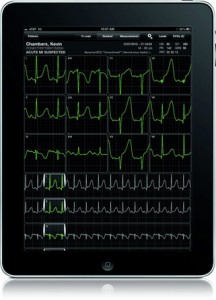 It might have been hard to stand out among the 1,123 exhibitors at the recent 2012 HIMSS conference two weeks ago, but AirStrip Technologies somehow did.
It might have been hard to stand out among the 1,123 exhibitors at the recent 2012 HIMSS conference two weeks ago, but AirStrip Technologies somehow did.
As MobiHealthNews Editor Brian Dolan reported, the San Antonio-based developer of remote monitoring apps recently landed separate investments from two heavyweights, namely the Qualcomm Life Fund and Hospital Corporation of America (HCA). Feb. 21, the first day of HIMSS started, AirStrip said that it would incorporate Diversinet authentication and encryption technology into its apps, likely allowing the company to sell its products to the Military Health System.
One day later, AirStrip expanded its existing partnership with GE Healthcare by announcing a collaboration on AirStrip Patient Monitoring, an app that sends data and waveform imaging from telemetry monitors to clinician iPads and iPhones in near real time. GE's Carescape network, a connectivity platform that helps integrate biomedical devices into hospital information systems, serves as the hub.
The two companies are positioning AirStrip Patient Monitoring as a form of clinical decision support that helps critical care physicians keep closer tabs on more patients than they otherwise would be able to without the technology. It also will help nurses in critical care units of hospitals track down physicians much faster when a patient monitor sounds an alarm.
The new app builds on an earlier joint offering, AirStrip Cardiology, an app that delivers digitally enhanced electrocardiogram images and reports to smartphones and tablets. "We are capturing clinical data and putting it on a mobile device," AirStrip CEO Alan Portela said in an interview at HIMSS12 in Las Vegas. "The concept is to decentralize data. Clinicians do not have to be tied to one location."
According to Portela, this technology helps address the dual problem of a shortage of caregivers – particularly nurses – in the face of a trend toward monitoring of more hospital beds. Portela cited data saying that U.S. hospitals now have monitors for 300,000 beds, up from just 70,000 three years ago, a number he said will reach 700,000 by 2015. "Eventually, every bed of the hospital will become closer to an ICU," Portela said.
This also aids primary care physicians in managing the care of their hospitalized patients. "Our analytics help docs become more proactive and less reactive," the AirStrip CEO said.
While it is too early to tell exactly what kinds of effects AirStrip Patient Monitoring will have on outcomes, Portela reported some positive results related to the cardiology app. In one test he discussed, a major teaching hospital reduced "door-to-balloon time" for cardiac catheterization in patients suffering segment-elevation myocardial infarction (STEMI) – a severe heart attack – from an average of 45 minutes down to about 20-25 minutes. "That's because the cath lab can be activated sooner after a quicker determination of STEMI," Portela said.
Patients are more likely to survive a STEMI, while hospitals should be able to cut length of stay and be able to turn beds over more quickly, according to Portela. Ready, mobile access to ECG results also helps save money, he said, because each unnecessary activation of a cath lab can cost upwards of $8,000. With bundled payments on the horizon, efficiency and waste reduction will be at a premium.
AirStrip Patient Monitoring and AirStrip Cardiology run on the same technology platform received FDA 510(k) clearance in 2010 and the European CE Mark at the very beginning of this year. (Portela said that the iPhone's and iPad's ability to zoom in on images while maintaining the same aspect ratio of the ECG viewed on a fixed workstation was "essential" to gaining FDA clearance.) The company has other products in development, also based on the core platform.
"The next thing to look at is home monitoring," Portela said, adding that care outside of traditional hospital and clinic settings will be essential elements in a world of bundled payments and accountable care organizations.













